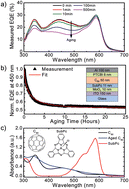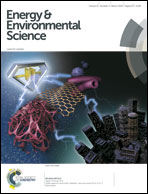Photochemical origins of burn-in degradation in small molecular weight organic photovoltaic cells
Abstract
Using a combination of Fourier transform infrared (FTIR) spectroscopy and physics-based degradation models, we find that the early aging of small molecular weight organic photovoltaic (OPV) cells is due to photochemical degradation of the C60 acceptor layer. Planar and mixed boron subphthalocyanine chloride (SubPc)-donor/C60-acceptor heterojunctions show significant changes in their IR absorption spectra after aging under illumination, which we find is due to exciton-mediated photo-oligomerization of C60. The consequent decrease in exciton diffusion length in the C60 layer results from a decreased exciton lifetime for C60 oligomers (e.g. C120 and C180) compared to that of the monomer. The model describes the short-circuit current reduction in planar SubPc/C60 OPV cells during early aging, and explains the lack of degradation in analogous mixed heterojunctions.


 Please wait while we load your content...
Please wait while we load your content...